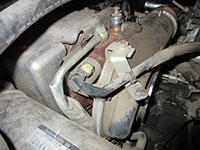The turbo VGT solenoid, sometimes always indicated as the VGT actuator, is a critical component of the variable geometry system. It ultimately adjusts or holds the position of the vanes in the turbine housing by metering the flow of engine oil into and out of the VGT armature piston cavity. The system is much less complicated that it may seem, but the vane position cannot be controlled the ECM without a properly functioning VGT solenoid.
Symptoms of a faulty or failed VGT solenoid include excessive turbo lag, low turbo boost, excessive smoke under load (particularly under high load at low engine speed), and/or poor overall performance. Any DTC related to low boost or turbocharger performance "out of range" can be cause by a malfunction with the VGT solenoid. However, a mechanically seized unison ring or VGT vanes can easily be disguised as a bad VGT solenoid as both will impede movement of the system. The simplest way to test the solenoid is to disconnect the electrical connector and measure the coil resistance across the two terminals with a multimeter. Resistance across the two pins should read between 3.42 and 4.18 Ω (Ohms) when the engine oil temperature (EOT) is at 73° F.
Click any thumbnail to view fullsize, detailed image
• Disconnect both negative battery cables.
• Remove the air intake resonator (plastic "6.6L Duramax" box above the turbocharger inlet).
• With the resonator removed, locate the VGT solenoid on the passenger side of the turbocharger bearing housing (center section of turbocharger).
• Remove the banjo bolt for the turbocharger oil feed line. Discard the copper crush washer; it will need to be replaced. This will allow the line to move freely so that it can be pushed out of the way to improve access to the VGT solenoid.
Note - alternatively, the oil feed line can be forced aside in most instances, however loosening the line increases access.
• Remove the VGT solenoid retaining bracket bolt using an 8 mm, 12 point socket; a 12 point socket must be used. The bolt is located beneath the solenoid itself (approximately 6 o'clock if viewing the solenoid from the passenger side fender). A 1/4" drive ratchet setup will fit between the VGT solenoid and EGR cooler, although it is a tight fit.
• Carefully remove the retaining bracket and bolt without letting it drop into the engine valley.
• Remove the VGT solenoid by pulling it out from inside the turbocharger housing while rotating side-to-side. The oil feed line will need to be manipulated to the side in order to clear the VGT solenoid as it is removed.
• Inspect the bore in the turbocharger and clean as necessary to prevent oil running down the side of the turbo.
• Lubricate the o-rings of the replacement VGT solenoid with clean engine oil. We actually soak the tip of the VGT solenoid in clean engine oil for several minutes so that everything is well lubricated, then let the excess drip off prior to installation. This method is highly recommended, however the most important point is that the o-rings are well lubricated prior to installation.
• Install the VGT solenoid and VGT solenoid retainer. Since the retaining bolt is difficult to reach, you may want to tape the bolt inside a deep socket and use the socket to start it by hand. Once started, simply pull off the bolt to break the tape seal. Tighten retaining bolt snug.
• Reconnect the VGT solenoid connector.
• Reinstall the turbocharger oil feed line (new crush washer highly recommended); torque to 19 ft-lbs.
• Reconnect the negative battery terminals, start the engine, and check for proper operation. Note that the ECM may need to re-map the VGT schedule before turbo operation becomes normal again; this will happen without intervention, however it may take several drive cycles before VGT vane position is optimized.









